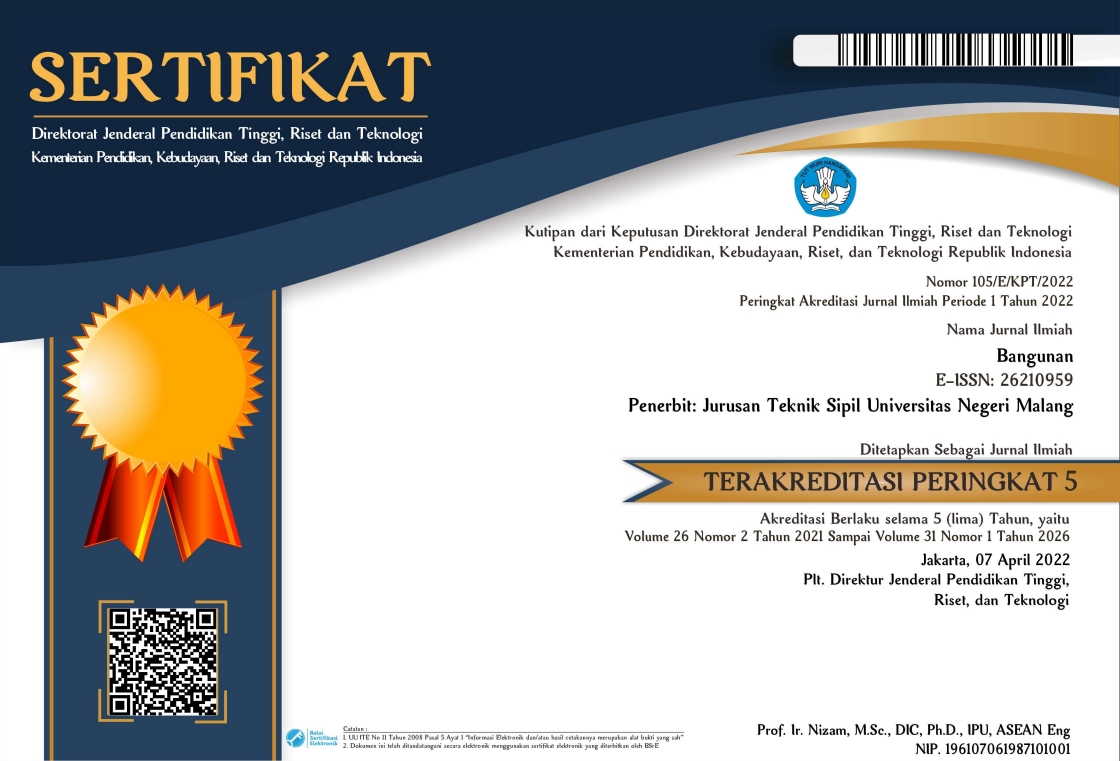INOVASI WATERPROOFING COATING CEMENT BASED DENGAN PEMANFAATAN LIMBAH STYROFOAM
Abstract
One of them is the porous structure, which triggers the loss of construction strength and causes the building structure to become brittle, so that a leak-proof or waterproof coating is needed to prevent water from penetrating into the building structure. In the market, waterproofing prices are relatively high, starting at one hundred thousand per kilogram, so waterproofing innovations are needed at affordable prices. The purpose of this research is to create a method for implementing and testing waterproofing coatings derived from a mixture of Styrofoam and additives, identify technical and physical data for waterproofing mixtures derived from test results, and analyze the best type of mixture of Styrofoam and additives for waterproofing. This study used styrofoam waste dissolved in thinner, which has the final property of water resistance, with added waterglass as an adhesive and shell waste and fly ash as cementitious solid additives. The research method used was experimental, with four variations of waterproofing mixtures using fly ash and clam shells added. Tests carried out based on SNI 8665:2018 in-packaging test, ASTM D1640 Touch dry and hard dry time test, ASTM D3359 pull-off adhesion test, SNI 0096:2007 Water permeability test, ASTM D471 water absorption test, ASTM D4798 Weather resistance test, and SNI 8665:2018 Spreadability test The results showed that of the 4 mixed variants, the optimum mixture was obtained in variation C with a ratio of 4:1:5 for dissolved styrofoam, waterglass, and dense fly ash added material. This mixture meets all the test criteria at a more affordable price than on the market. So by utilizing this waste for waterproofing, it is hoped that it can reduce Styrofoam waste, which is difficult to decompose and abundant in Indonesia, and meet the needs of the waterproofing market.
Full Text:
PDFReferences
Jun Chang, W. L. (2020, April 13). Effect of silicate modulus on tensile properties and microstructure of waterproof coating based on polymer and sodium silicate-activated GGBS. Construction and building material, 1-10.
Iskandar, V. (2017). WATERPROOFING. Jenis Waterproofing. (online) Retrieved from docplayer.info:https://docplayer.info/43711553-Waterproofing-jeniswaterproofing.html , diakses 5 Maret 2022.
Effendi, A. H. (2007, September). Natrium silikat sebagai bahan penghambat api aman lingkungan. Jurnal teknik lingkungan, 8, 245-252.
ASTM D1640. (2009). Standard Test Methods for Drying, Curing, or Film Formation of Organic Coatings. America; ASTM International
ASTM D3359. (2017). Standard test methods for rating adhesion by tape test. America; ASTM International
ASTM D4798.(2016). Standard Practice for Accelerated Weathering Test Conditions and Procedures for Bituminous Materials (Xenon-Arc Method). America; ASTM International
ASTM D471. (1991). Standard tes method for Rubber Property-Effect of Liquids. America; ASTM International
SNI 8665:2018. (2018). Cat pelapis anti bocor berbasis air. Jakarta; Badan Standardisasi Nasional
SNI 0096:2007. (2007). Genteng Beton. Jakarta; Badan Standardisasi Nasional
Tong, Zhineng. (2015). Penelitian Teknologi Kedap Air Teknik Konstruksi. Iptek Universitas.
Pratama, Ryan Syaafatillah. (2019). Pengaruh Komposisi Campuran Thinner Terhadap Ketebalan Dan Daya Lekat Pengecatan Pada Plat Baja Spcc.Skripsi. Jurusan Teknik Mesin Fakultas Teknik.Universitas Negeri Semarang
Abd. Rahman, F. M. (2014). Studi Pembuatan Cat Tembok Emulsi dengan Menggunakan kapur sebagai bahan pengisi. Jurnal Rekayasa Kimia dan Lingkungan, 10 no.2, 63-69.
Muh Wahyu Syabani, I. P. (2017). Thermal Degradation of Modified Phenol-Formaldehyde Resin with sodium silicate. International Conference on Chemistry and Engineering in Agroindustry(978-602-50936-0-9), 37-40.
Pantri Asbiartha, A. A. (2022, April). Pengaruh serbuk cangkang kerang dara dan lokan sebagai penggant sebagian semen terhadap berat volume, kuat tekan, dan kuat tarik belah beton. Jurnal Selodang Mayang, 8 no.1(2620-3332), 48-56.
Roziqin, M. (2020). Pengaruh penambahan fly ash terhadap sifat mekanik beton integral waterproofing. Jember: Universitas Jember.
Siregar, S. M. (2009). PEMANFAATAN KULIT KERANG DAN RESIN EPOKSI TERHADAP KARAKTERISTIK BETON POLIMER. Medan: Universitas sumatera utara.
Solikin, M. M. (2022). ANALISIS PENGARUH PENGGUNAAN VARIASI FLY ASH TERHADAP KARAKTERISTIK BETON DENGAN PENAMBAHAN KAPUR TOHOR. Prosiding Seminar Nasional Teknik Sipil(2459-9727), 29-36.
DOI: http://dx.doi.org/10.17977/um071v28i22023p1-10
Refbacks
- There are currently no refbacks.

This work is licensed under a Creative Commons Attribution-ShareAlike 4.0 International License.

This work is licensed under a Creative Commons Attribution-ShareAlike 4.0 International License.


